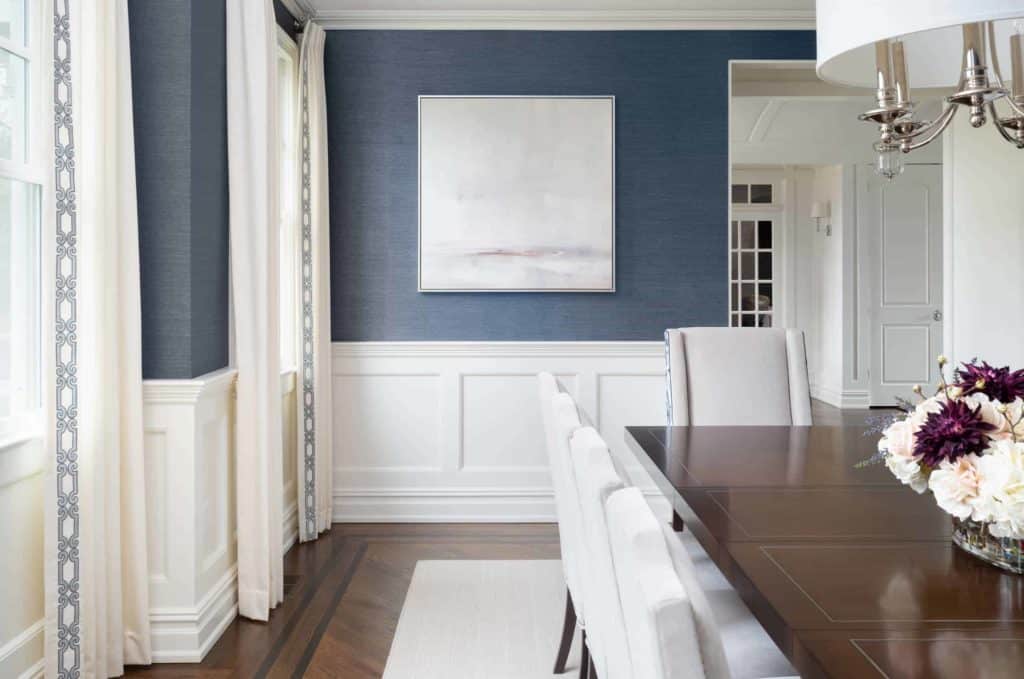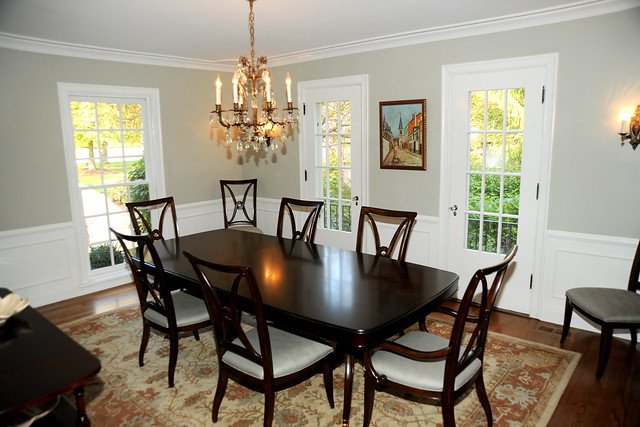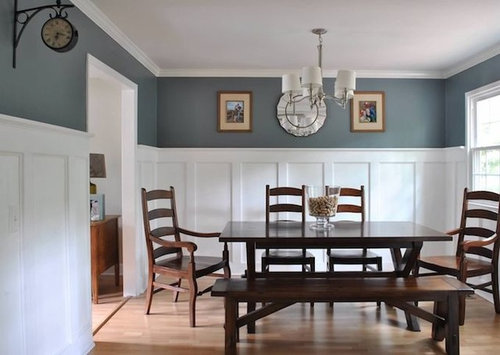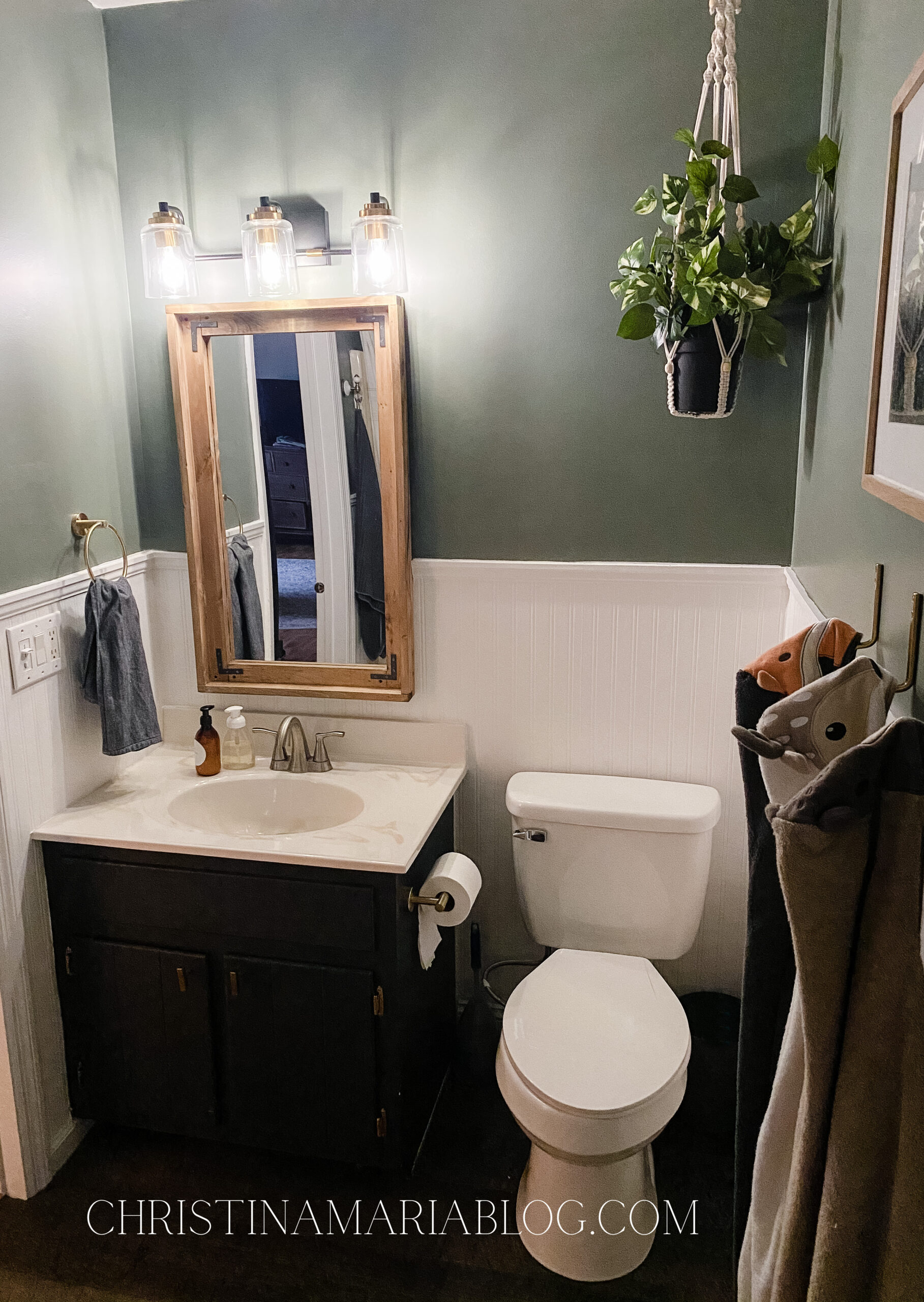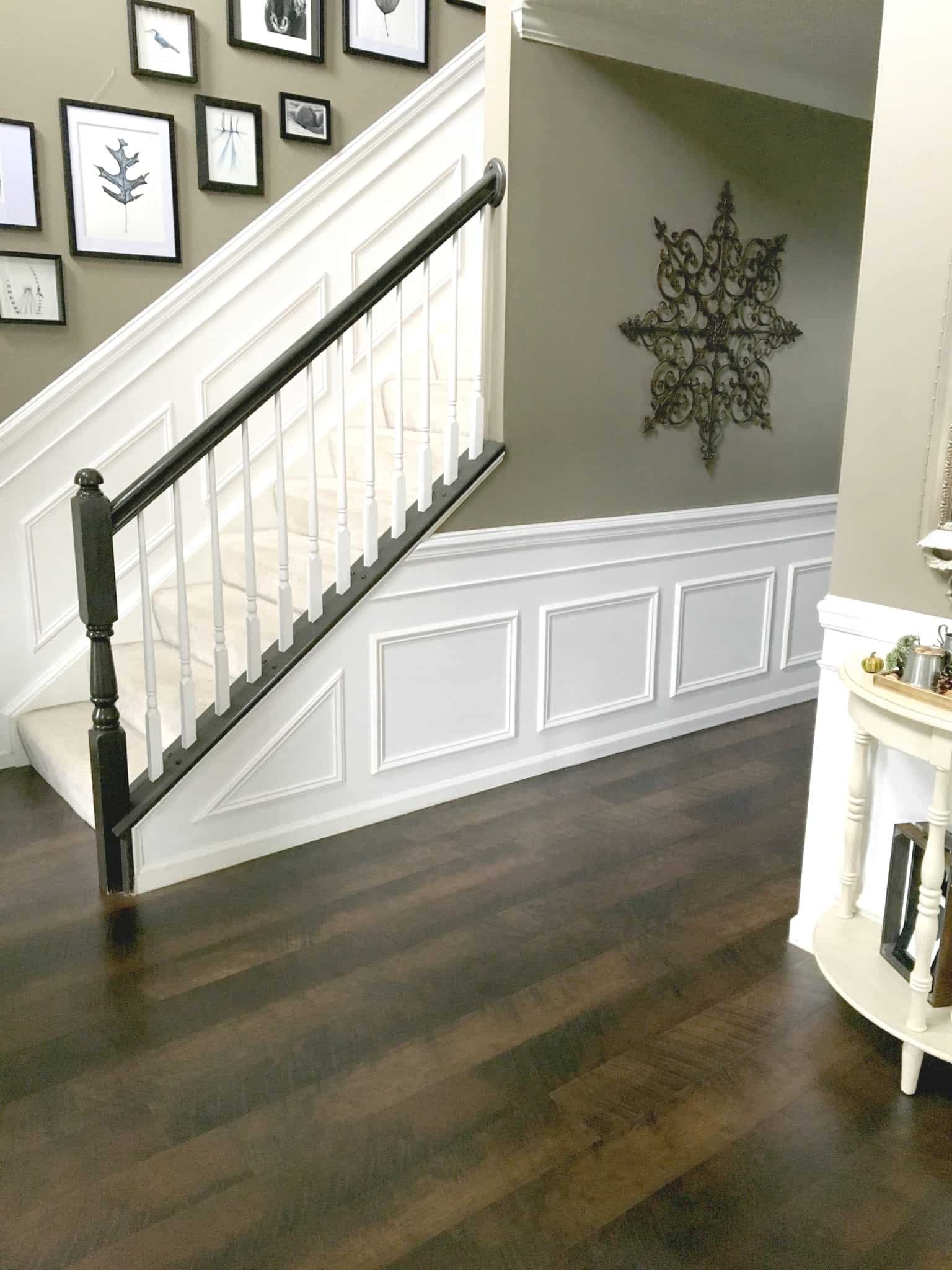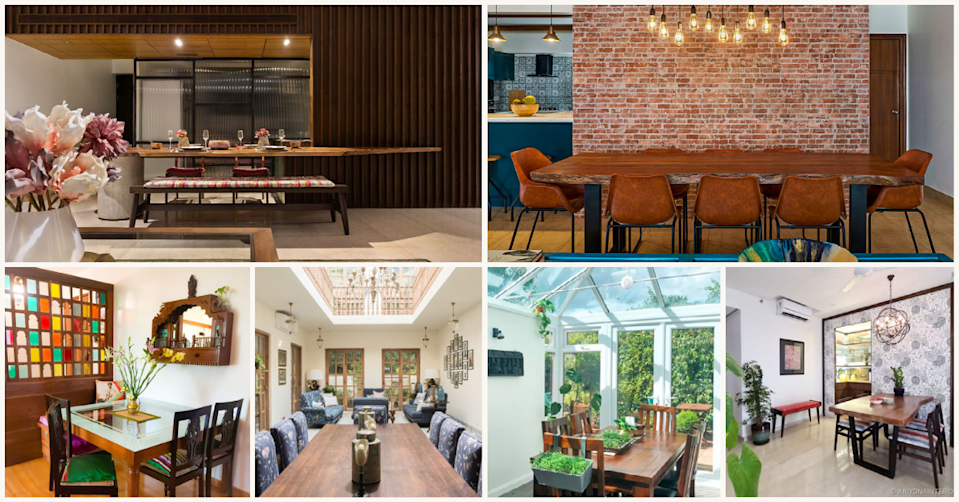If you have a smaller dining room, don't shy away from wainscoting. Shorter wainscoting can be just as impactful as full-height wainscoting, if not more. Here are some ideas to inspire you: 1. Beadboard wainscoting: Beadboard is a popular type of wainscoting that features evenly spaced vertical grooves. This type of wainscoting is perfect for smaller dining rooms as it can make the walls appear taller. Paint it in a crisp white for a classic and timeless look, or add a pop of color for a more contemporary feel. 2. Raised panel wainscoting: This type of wainscoting features a series of raised panels that add dimension and visual interest to the walls. Raised panel wainscoting can be used in shorter lengths to create a more subtle and elegant look in a dining room. Consider painting it in a rich, dark color for a luxurious touch. 3. Shiplap wainscoting: Shiplap is a type of wainscoting that features overlapping wooden boards. It has gained popularity in recent years and is a great option for those looking for a more rustic or farmhouse aesthetic. Shiplap wainscoting can be used in shorter lengths to add texture and warmth to a dining room.Shorter Wainscoting Ideas for Dining Room
4. Picture frame wainscoting: This type of wainscoting consists of rectangular frames that are applied to the walls and can be used in shorter lengths for a more subtle effect. You can get creative with the size and placement of the frames to add a unique touch to your dining room walls. 5. Board and batten wainscoting: Board and batten wainscoting is a classic and versatile option for any room. It features a combination of vertical boards and smaller horizontal battens. When used in shorter lengths, it can add a touch of sophistication to a dining room without overwhelming the space. 6. Wainscoting with wallpaper: If you want to add some pattern and color to your dining room walls, consider combining wainscoting with wallpaper. You can use shorter wainscoting panels and cover the upper portion of the wall with a bold and eye-catching wallpaper to create a statement feature in your dining room.Wainscoting Styles for Smaller Dining Rooms
Installing wainscoting may seem like a daunting task, but it's actually a relatively simple DIY project. Here are the basic steps to follow: 1. Measure your walls: Start by measuring the length and height of your walls to determine the amount of wainscoting you will need. 2. Gather your materials: You will need wainscoting panels, a saw, a level, a nail gun or hammer, adhesive, and paint or stain for the panels. 3. Cut the panels to size: Use a saw to cut the wainscoting panels to the appropriate length for your walls. 4. Apply adhesive: Apply a strong adhesive to the back of the panels and press them onto the wall, making sure they are level. 5. Secure with nails: Use a nail gun or hammer to secure the panels in place. 6. Fill in gaps and nail holes: Use wood filler to fill in any gaps between the panels and use putty to fill in any nail holes. Sand the surface for a smooth finish. 7. Paint or stain: Finally, paint or stain the wainscoting to your desired color.How to Install Shorter Wainscoting in Your Dining Room
If you're on a budget but still want to add some wainscoting to your dining room, don't worry. There are plenty of affordable options out there. Here are a few ideas to consider: 1. Faux wainscoting: You can achieve the look of wainscoting without breaking the bank by using faux panels made of lightweight materials such as foam or PVC. These panels are easy to install and can be painted to look like real wainscoting. 2. Pre-made wainscoting kits: You can also purchase pre-made wainscoting kits that include all the materials you need to install wainscoting in your dining room. These kits are often more affordable than buying individual materials. 3. Repurpose old materials: You can get creative and repurpose old materials such as pallet wood or old doors to create a unique and budget-friendly wainscoting in your dining room.Budget-Friendly Short Wainscoting Options for Dining Rooms
Shorter wainscoting can be used in various ways to add personality and charm to your dining room. Here are a few creative ideas to consider: 1. Half-walls: Instead of covering the entire wall with wainscoting, you can use shorter panels to create a half-wall effect. This can add a touch of elegance and sophistication to your dining room. 2. Accent wall: You can also use shorter wainscoting on just one wall to create an accent feature in your dining room. This is a great way to add interest without overwhelming the space. 3. Combined with other materials: Shorter wainscoting can be combined with other materials such as tile or wallpaper to create a unique and eye-catching feature wall in your dining room.Creative Ways to Use Short Wainscoting in Dining Rooms
While full-height wainscoting may be the traditional choice for dining rooms, shorter wainscoting has its own advantages. Here are some pros and cons to consider: Pros of shorter wainscoting: - More affordable - Easier to install - Can be used in smaller spaces - Can still add texture and character to the walls Cons of shorter wainscoting: - May not have the same dramatic effect as full-height wainscoting - May not be suitable for larger dining roomsShort Wainscoting vs. Full-Height Wainscoting for Dining Rooms
If you're feeling handy, here are some fun and creative DIY projects using shorter wainscoting for your dining room: 1. Add a chair rail: A chair rail is a horizontal molding placed on the walls at the height of a chair back. You can use shorter wainscoting panels to create a chair rail effect in your dining room. 2. Create a paneling effect: Instead of covering the entire wall with wainscoting panels, you can use shorter panels to create a paneled effect on the lower portion of the wall. This is a great option for those who want a more subtle wainscoting look. 3. Add a shelf: You can attach a shelf to the top of your wainscoting panels to create a functional and decorative feature in your dining room. This is a great way to display your favorite dishes or decor items.DIY Short Wainscoting Projects for Dining Rooms
When it comes to choosing the color for your shorter wainscoting, the possibilities are endless. Here are some ideas to get you started: 1. Classic white: You can't go wrong with a classic white wainscoting. It's timeless, versatile, and can make your dining room feel brighter and more spacious. 2. Bold and colorful: If you want to make a statement, consider painting your wainscoting in a bold and vibrant color. This can add a fun and playful touch to your dining room. 3. Natural wood: Another option is to leave your wainscoting in its natural wood state. This can add warmth and texture to your dining room walls and create a cozy and inviting atmosphere.Short Wainscoting Color Ideas for Dining Rooms
Pros of shorter wainscoting: - Can add texture and character to the walls - Can be more affordable than full-height wainscoting - Can be used in smaller spaces - Can be easier to install Cons of shorter wainscoting: - May not have the same impact as full-height wainscoting - May not be suitable for larger dining roomsPros and Cons of Short Wainscoting in Dining Rooms
Here are some tips to help you seamlessly integrate shorter wainscoting into your dining room design: 1. Consider the height of your ceilings: Shorter wainscoting may not be suitable for rooms with high ceilings as it may make the space feel unbalanced. Make sure to consider the proportions of your room when deciding on the height of your wainscoting. 2. Choose complementary materials: Make sure to choose materials and colors that complement the rest of your dining room design. This will help create a cohesive and polished look. 3. Don't be afraid to mix and match: Wainscoting doesn't have to be uniform throughout the room. You can mix and match different styles and heights to create a unique and interesting feature. In conclusion, shorter wainscoting can be a great option for smaller dining rooms. It can add character, texture, and warmth to your walls without overwhelming the space. With the right materials, colors, and installation techniques, you can transform your dining room into a cozy and stylish gathering spot that your family and friends will love. So don't be afraid to get creative and experiment with different styles to find the perfect shorter wainscoting for your dining room.How to Incorporate Short Wainscoting into Your Dining Room Design
The Benefits of Shorter Wainscoting in Your Dining Room

What is Wainscoting?
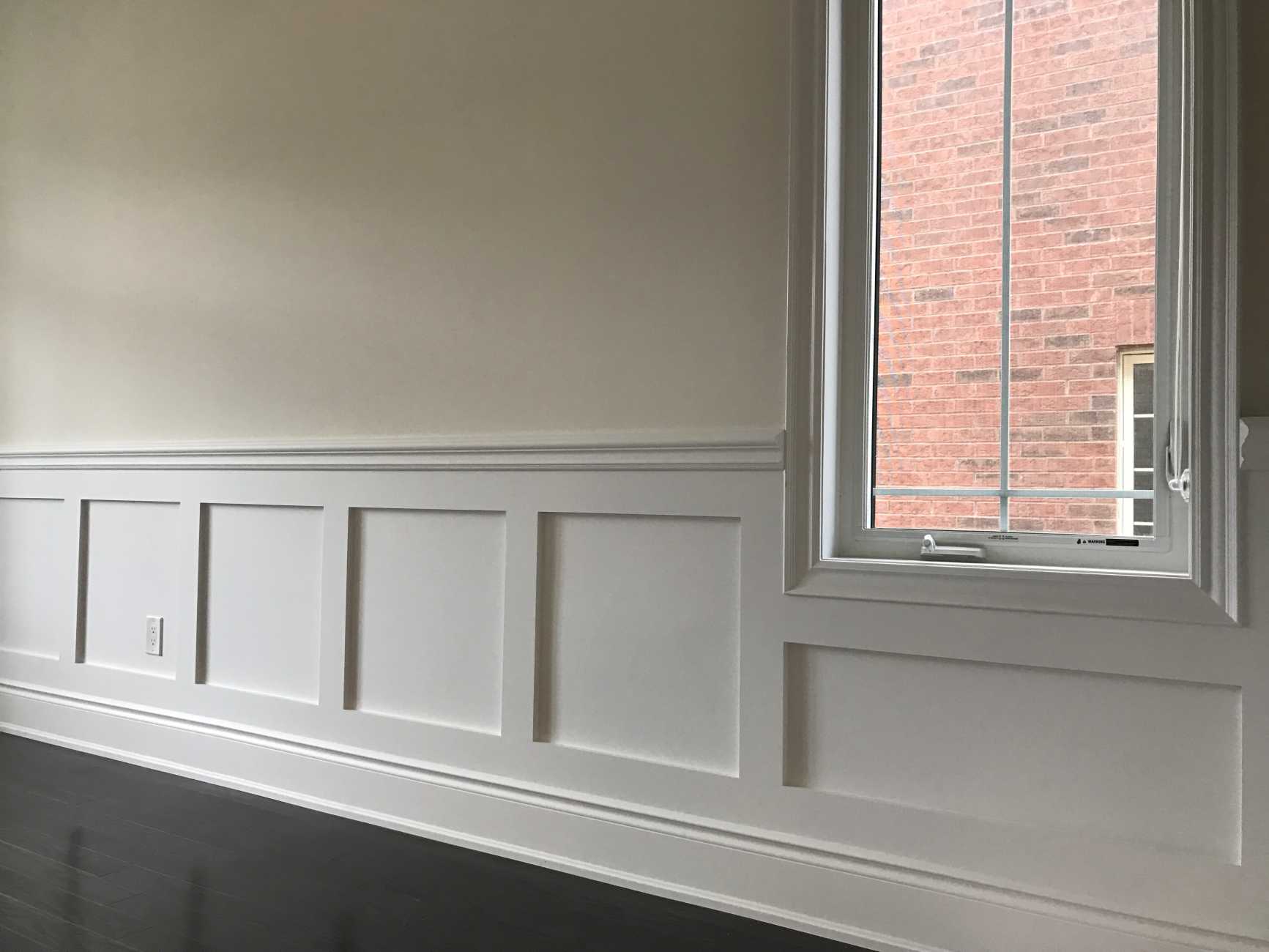 Wainscoting refers to the decorative paneling that is used on the lower half of the walls in a room. It has been a popular design feature in homes for centuries, adding both elegance and practicality to a space. Traditionally, wainscoting was taller and covered a larger portion of the wall, but in recent years, shorter wainscoting has become a popular trend in interior design.
Wainscoting refers to the decorative paneling that is used on the lower half of the walls in a room. It has been a popular design feature in homes for centuries, adding both elegance and practicality to a space. Traditionally, wainscoting was taller and covered a larger portion of the wall, but in recent years, shorter wainscoting has become a popular trend in interior design.
The Appeal of Shorter Wainscoting
 Shorter wainscoting, also known as half-wall paneling, typically covers only the lower third of a wall, making it a perfect choice for dining rooms. This style of wainscoting not only adds a touch of sophistication and charm to the room, but it also serves a functional purpose. It can protect your walls from scratches and marks, especially in high-traffic areas such as dining rooms.
Shorter wainscoting, also known as half-wall paneling, typically covers only the lower third of a wall, making it a perfect choice for dining rooms. This style of wainscoting not only adds a touch of sophistication and charm to the room, but it also serves a functional purpose. It can protect your walls from scratches and marks, especially in high-traffic areas such as dining rooms.
Creating a Cozy Atmosphere
 One of the key benefits of shorter wainscoting in a dining room is the cozy atmosphere it creates. By covering only the lower portion of the wall, it allows the upper walls to be painted in a different color or wallpapered, adding depth and character to the space. This can make the room feel more intimate and inviting, perfect for hosting dinner parties or enjoying family meals.
One of the key benefits of shorter wainscoting in a dining room is the cozy atmosphere it creates. By covering only the lower portion of the wall, it allows the upper walls to be painted in a different color or wallpapered, adding depth and character to the space. This can make the room feel more intimate and inviting, perfect for hosting dinner parties or enjoying family meals.
Design Options
Cost-Effective Solution
 Another advantage of shorter wainscoting is that it is a more cost-effective option compared to full-height wainscoting. This is because it requires less material and labor, making it a budget-friendly choice for homeowners who want to add a touch of elegance to their dining room without breaking the bank.
Another advantage of shorter wainscoting is that it is a more cost-effective option compared to full-height wainscoting. This is because it requires less material and labor, making it a budget-friendly choice for homeowners who want to add a touch of elegance to their dining room without breaking the bank.
Final Thoughts
 Shorter wainscoting is a versatile and stylish design feature that can enhance the look and feel of your dining room. It adds character, protects your walls, and creates a cozy atmosphere, all while being a cost-effective solution. Consider incorporating this trend in your dining room for a touch of sophistication and charm.
Shorter wainscoting is a versatile and stylish design feature that can enhance the look and feel of your dining room. It adds character, protects your walls, and creates a cozy atmosphere, all while being a cost-effective solution. Consider incorporating this trend in your dining room for a touch of sophistication and charm.




